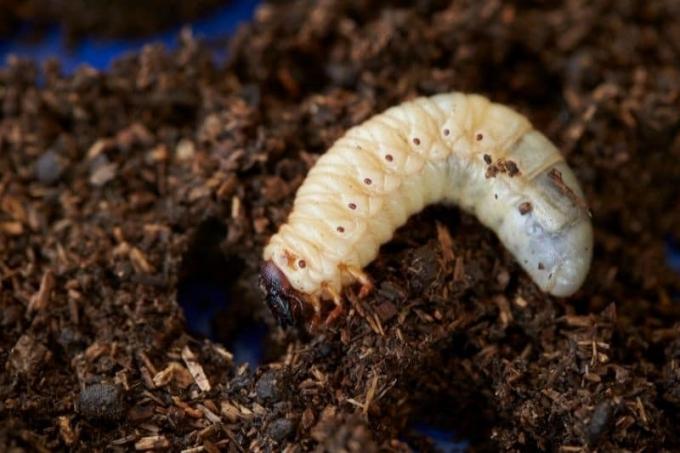
Although the previously decorative roses have received enough water, the stems and leaves suddenly begin to wither and the roses dry up. There can be various causes for this, if these are recognized early, the plants may still be able to be saved.
In a nutshell
- This is often caused by pests or a fungal attack
- Waterlogging also causes roses to wither
- In case of waterlogging or pests, dig up roses and replant them
- some rose varieties need radical pruning to the rescue
Table of Contents
- Possible causes
- Foliage and shoot damage
- root damage
- save roses
- Prevent
- frequently asked Questions
Possible causes
If the roses suddenly dry up and the stems and leaves wilt, this can have various causes. There are three different types of damage occurring in roses:
- foliage damage
- drive damage
- root damage
Tip: You can scratch the shoots with a nail. If it is still green under the surface, the stalk has not dried out and does not need to be removed. You should only remove dead wood.
Foliage and shoot damage
In the case of foliage or shoot damage, the roots are not affected. This damage can be caused by a fungal attack or pests:
- rose rust
- blackspot
- powdery mildew and downy mildew
- Leaf and stem blight (Cylindrocladium scoparium)
- Fungus that enters through the leaves
- aphids
- spider mites
- Rose shoot borer (Blennocampa elongatula, Ardis brunniventris)

In such a case, the roses can usually be saved by pruning them back to the vine. Depending on the situation, a fungicide or insecticide can also help. After some time, the plant will sprout again from below. If only the leaves are affected, it is usually sufficient to remove them and cut off a piece of the shoots.
A notice: If the rose is infested with the rose shoot borer, which is the larvae of the sawfly, the shoots also look like they have dried up. This is because the pest bores through the shoot from the inside and hollows it out. You must also remove these shoots immediately to avoid further damage.
root damage
If it is the roots that are causing the roses to dry up, then there are different causes here as well which prevent the roots from absorbing sufficient water from the soil and passing it on to the plant be able. This can be caused by both waterlogging and not enough watering. But pests can also cause great damage to the roots, which then no longer absorb water. Pests include:
- three aquatic mushroom species: Phytophthora cactorum, Phytophthora cinnamomi, Phytophthora cambivora
- Rosellia necatrix, a fungus that causes white root rot
- Garden beetle larvae (Phyllopertha horticola) feed on rose roots, among other things

save roses
In the event of root damage from fungi, the rose can usually no longer be saved and it should be disposed of in the residual waste. If the plant has dried up due to too little water, then all dry shoots can be cut back or the rose can be cut back completely to the stock. After that, it must be watered sufficiently for days. Most of the time, the plants then quickly sprout again from below. In the event of waterlogging or infestation of grubs, the following steps must be taken according to the instructions:
- Prick with a spade around the root ball
- Carefully dig out and lift out the rose bush
- Clean roots of all soil
- Remove infected roots with clean and disinfected scissors
- Cut off dried shoots
- If the cause is waterlogging, allow the root ball to dry off
- Replant roses elsewhere in fresh and composted soil
A notice: If waterlogging has been identified as the cause, you should not water the roses immediately after replanting and let them dry for a few days before watering moderately. If grubs are infested, you can water the roses well immediately after planting.
Prevent
The best way to prevent roses from dying is to first choose the hardy varieties of the ADR for cultivation. Nevertheless, these varieties also require preventive care to prevent them from drying out:
- Location requirements must be right
- fertilize regularly and sufficiently
- water appropriately
- keep enough distance when planting
- helps against fungal infestation
- Leaves can dry better after rain
- take appropriate measures for wintering

Tip: Optimal care is the best prevention against sudden drying out.
frequently asked Questions
Plant parts that have been attacked by a fungus such as rose rust or powdery mildew should never be placed in the compost or green waste. Because here the fungus can live on and the spores can spread either from the compost into the garden or through fertilization. The same applies to green waste. Therefore, put everything well sealed in the residual waste.
If the plant has dried shoots after a long, cold winter, it doesn't have to be because it's frozen. Because it is also possible that it has not received any water due to a long dry period in winter and has dried out. You can try to save the rose by pruning it back to the cane and watering well. If small shoots appear in spring, the plant is saved.
The ADR roses come in different varieties, such as bush, climbing or bed roses. The "General German Rose Novelty Test" (ADR) tests the newly bred rose varieties and is thus considered a rose TÜV. Above all, care is taken to ensure that the varieties are particularly resistant to diseases without the use of chemicals.
